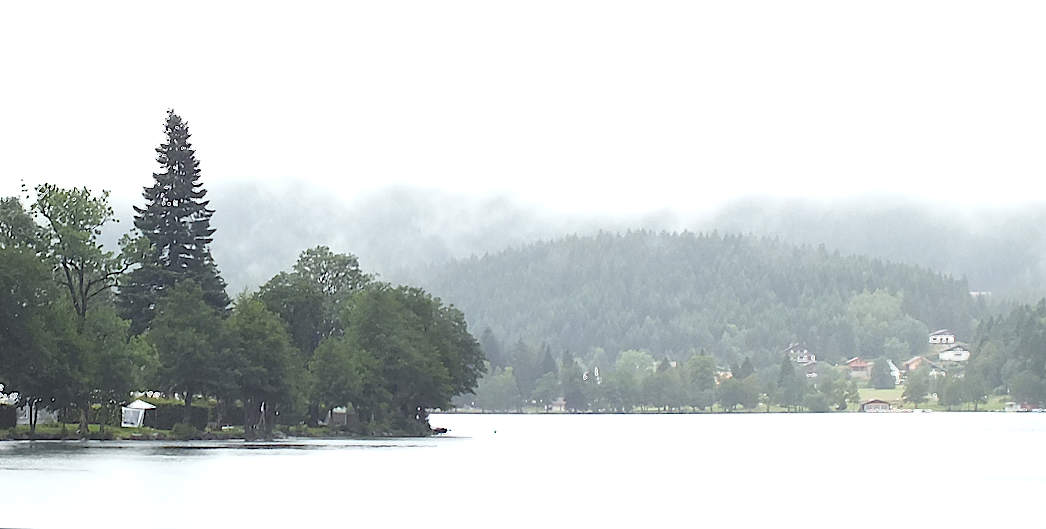
Lorraine - an area guide
A discovery of Lorraine - sights and tourism
- Explore France ►
- Essential pages
- Travel in France
- Where to go
- What to see and do
About-France.com
- the connoisseur's guide to France
Located
in the northeast of France, on the borders of Belgium, Luxembourg and
Germany, Lorraine
is one of the old historic provinces of France and Europe, established
in the ninth century as the land of Lothair, grandson of the emperor
Charlemagne.| Page index | Regional information | Main tourist attractions | Hotels in Lorraine |
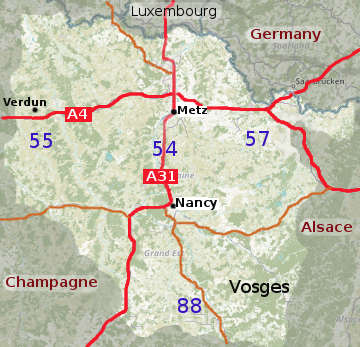 The Lorraine area consists of four
departments,
Meurthe-et-Moselle
(54), Meuse
(55), Moselle
(57), and Vosges
(88). It is the only French region to border on three different foreign
countries – Belgium, Luxembourg, and Germany: it also borders
on three
other French regions, Alsace
to the east, Champagne-Ardenne
to the west, and Franche-Comté
to the south.
The Lorraine area consists of four
departments,
Meurthe-et-Moselle
(54), Meuse
(55), Moselle
(57), and Vosges
(88). It is the only French region to border on three different foreign
countries – Belgium, Luxembourg, and Germany: it also borders
on three
other French regions, Alsace
to the east, Champagne-Ardenne
to the west, and Franche-Comté
to the south.Lorraine was not always part of France. When, in the 9th century, Charlemagne divided his empire into three parts, Lorraine, like today's Luxembourg, Holland and Belgium, was part of the middle Empire, between France in the west and Germany in the east. This middle section of the Carolingian empire was bequeathed to Charlemagne's grandson Lothair, and was thus known as Lotharingia, which has given the modern name Lorraine.

Joan of Arc, or as the French call her Jeanne d'Arc, is doubtless the most famous child of Lorraine, and her birthplace can be visited in the village of Domrémy-la-Pucelle, in the Vosges department.
Accommodation in Lorraine
Hotels:
Find and book hotels in Lorraine. Click on place names for a choice of hotel accommodation available at the best online rates.- Hotels throughout Lorraine
- Hotels in Nancy
- Hotels in Metz
- Hotels in and around Verdun
- Small hotels in the east of France
Gites:
Gites in Lorraine
As for the Vosges mountains, they still support a textile industry as well as a sawing and wood-milling industry. While nothing like as active as it was in its heyday, the Vosges textile industry is still active, and Vosges linen is reputed throughout France for its tradition and quality.
Unlike other French regions, Lorraine, though a historic region, does not have a single natural capital; the region's two major cities, Metz and Nancy, are of similar size (each with an urban area of around 420,000 inhabitants), and have both been regional capital at times in history.
Today's capital is Metz, préfecture of the Moselle department, and one of the oldest cities in France. It was in Metz that the Carolingian dynasty first came to power, and from the tenth to the seventeenth century, Metz was a city of the (Germanic) Holy Roman Empire, only becoming French on the signing of the Treaty of Westphalia in 1648.
Nancy, by contrast, is a much more recent city. Developing in the Middle Ages, it blossomed into a major regional city in the eighteenth century, as capital of the new French duchy of Lorraine. It was Stanislas, deposed king of Poland, to whom the duchy was given in 1737, who developed the great neo-classical city with its magnificent central square named in his honour.

Historic working sawmill in the Vosges mountains
Main tourist attractions in Lorraine
Areas and multi-sites:
- Amnéville (57) : Zoological park. This 40 acre zoo is one of the three largest in France in terms of species represented; it is strongly involved in conservation of rare species.
- Domrémy la Pucelle (88) : birthplace of Joan of Arc, Joan of Arc interpretive centre, and pilgrimage basilica.
- Gerardmer (88) Mountain resort in the Vosges, famous for its lake and natural environment.
- Jeanménil: (88) Fraipertuis-city. Wild-west theme park, in the forests of the Vosges.
- La Bresse-Hohneck (88) : the biggest ski area in north east France. 21 km of pistes, 21ski lifts. Altitude 900 to 1350 m.
- Malbrouk (57). right on the border with Germany, this castle owes its name to the duke of Marlborough, who used it as his headquarters in 1705.
- Metz (57) Cathedral St. Etienne, gothic cathedral with fine stained glass: Eglise St. Pierre aux Nonnains, supposedly the oldest church in France. Musées de la Cour d'or. Place St Louis (14th Century), renaissance and medieval architecture in the old city. The neo-romanesque railway station, finished 1908, is among the finest in France.
- Metz (57) Opened 2010. Centre Pompidou Metz. New museum of modern and contemporary art, a satellite of the famous Paris museum. One of Europe's major museums of modern art, providing extra display space for the Paris collection.
- Meuse-Argonne American cemetery (55). The largest American military cemetery in Europe, with over 14,000 war graves from World War 1. Located among the main battlefields of the 1918 offensive
- Nancy (54) : Place Stanislas, one of the finest city squares in France, a UNESCO World Heritage site, with two other 18th century squares. Porte de la Craffe (14th Century) and other remains of the medieval city.
- Neufchef (57) Mineral mining museum; take an underground trip with a former miners in this industrial museum
- Petite Rosselle (57) La Mine, Musée Carreau Wendel. Opened in 2006, an exceptional coal mining museum, with a visit into the "bowels of the earth". the visit lasts 2 hours.
- Rodemack (57) Nicknamed the Carcassonne of Lorraine, Rodemack, 7 km from the Luxembourg border, is a "medieval village" protected by its ramparts and its castle
- Sarrebourg (57) East of the town, in the Vosges hills, the Abreschviller Forest steam railway. 12 km trip.
- Stenay (55) Between Sedan and Verdun. Beside the river Meuse, the European museum of beer. a fascinating and well documented exploration of the history and production of beer.
- Vekring (57) Ouvrage du Hackenberg, part of France's Maginot Line defences in the First World War.
- Verdun (55): The Memorial is a museum devoted to the battle that lasted almost a year, taking 300,000 French lives. (see WW1 sites and map),
- Vosges mountains (57, 88) Hiking, mountain biking, nature, skiing in winter.
And nearby:
- Luxembourg: One of Europe's smallest states. Historic capital city, offices of the European Union.
- Trier (Trèves): old German city on the Moselle, with impressive romanesque basilica and other historic monuments.
- The Moselle valley in Germany, with its terraced vineyards and famous wines.
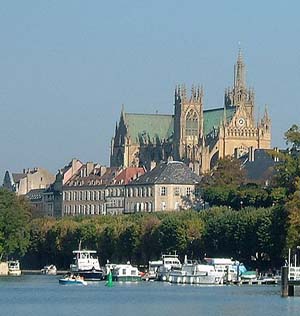
Old Metz, with St Etienne's Cathedral

Nancy, Porte Héré, Place Stanislas.
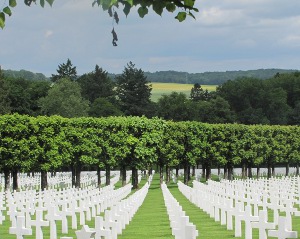
North of Verdun - the cemetry of Meuse-Argonne, near Montfaucon - the largest US war cemetery in Europe.
Photo About-France.com
About-France.com
Home
page - Site
search
- Regions
- Maps of France
- Contact
Going further: Official Lorraine
tourism site
Photo top of page. Lac de Longuemer in the Vosges, on a dull day..... and below the same on a sunny day.
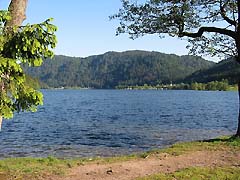
Travel
information -
Getting to Lorraine:
By
TGV from Paris Gare de l'Est , or from Strasbourg.Access by car from the UK: the easiest way is to cross to Calais, then drive down the A26 motorway as far as Reims, then follow the A4 motorway which cuts through the middle of Lorraine. From Benelux: travel via south Belgium and Luxembourg.
By plane: there are no flights from the UK or the USA to Lorraine. Nearest airports are Luxembourg, Paris CDG, and Strasbourg.
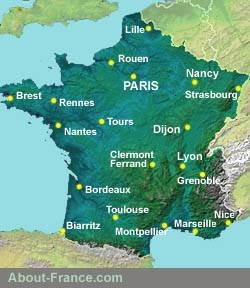
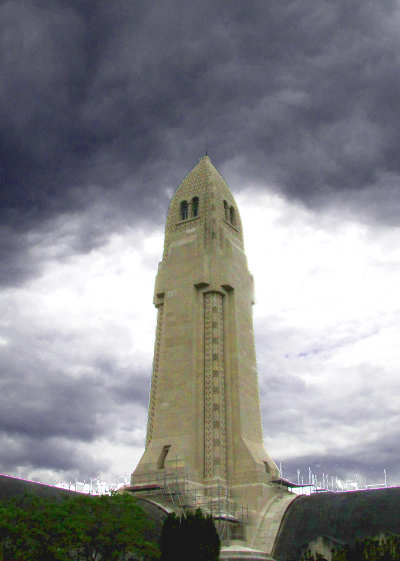
The Duaumont memorial on the site of the First World War battle of Verdun, where over 300,000 men perished.
Click here for
low-cost car hire in France
low-cost car hire in France
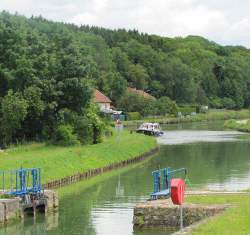
Boating in the Meuse valley
Text and photos Copyright © About-France.com
Except:
Photos of Nancy by Enslin - Licence Creative commons.
Longuemer on a sunny day © Christian Amet Licence GNU
Map
by About-France.com on an open source base from OpenStreetmap.org
